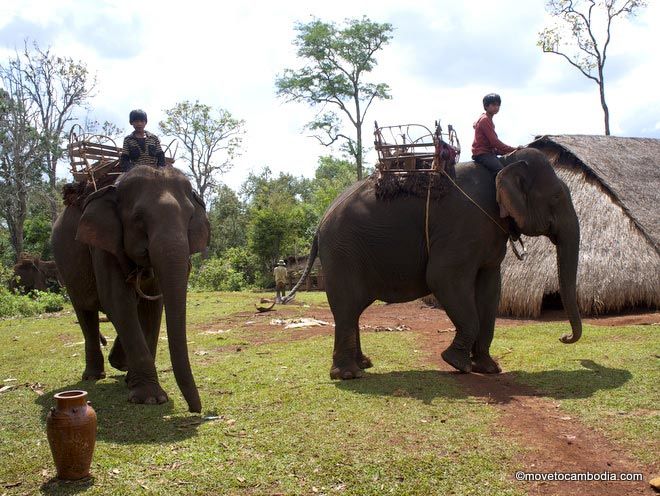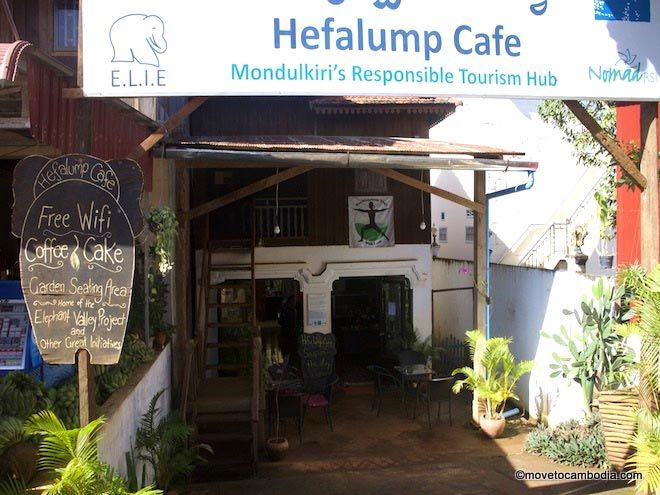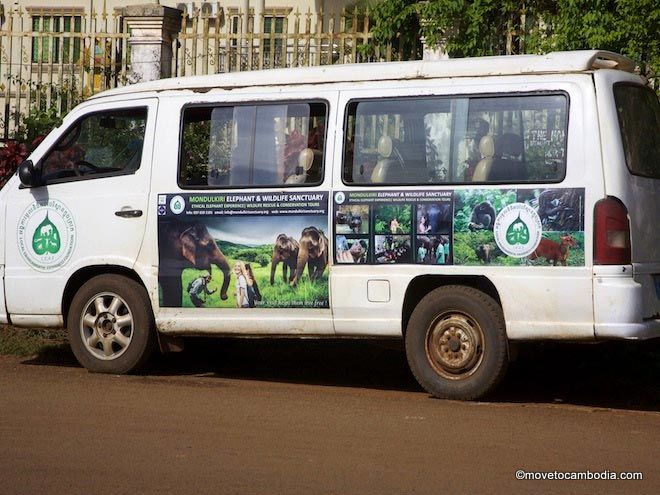No mention of Mondulkiri would be complete without its star attraction, the Asian elephant. In Cambodia, the second largest land mammal’s numbers have dwindled significantly in the last 20 years, and recent estimates put the current population between 250 and 600 in the wild. But only around 48 elephants are domesticated, meaning that all revenue-generating elephant activities — from elephant rides and treks to moving logs — are concentrated in a very small, aging population spread out between quite a few villages, camps, and sanctuaries. If you’re hoping to see these majestic beasts in Cambodia, Mondulkiri is the place to go.

Hoping to set eyes on an Asian elephant? Head to Mondulkiri.
Elephants naturally need very little sleep, and instead spend as much as 18 hours a day eating in order to get sufficient calories. Time spent doing multiple tours and treks for tourists can be very taxing, and over time lead the elephants to be tired, prone to injury, undernourished, and dehydrated. Add to that mix fierce the competition for tourist dollars and you can imagine that the elephant tourism industry in Mondulkiri is competitive, and at times, controversial. We’re here to help you make sure that your money is going to local people and to good treatment of the elephants through responsible elephant tourism.
Elephant Valley Project (EVP) is the longest-standing and most well-regarded elephant organization in the area. They run a sanctuary for retired working elephants that permits their owners to continue to receive a monthly “wage” from the elephant, and veterinary facilities, as well as support the surrounding villages and protected forest area with healthcare, jobs, support for schools, land rights for the local Bunong people, and other community development initiatives. There is a big focus on accountability to the surrounding villages, the natural lives of the elephants, and to the ecosystem overall in EVP’s approach, and their community programs are extensive and well-documented, managed and evaluated. Read more about them here.
Visitors can walk around the lushly forested grounds and up and down the hills to various parts of the sanctuary (wear appropriate footwear, especially during rainy season!) to see the elephants in their natural habitat, and can interact with them at close range, including for the elephants’ daily baths. There is no riding or swimming with the elephants, although if comfortable, the elephants will sometimes allow visitors to touch them and feed them.

Organize your visit to the Elephant Valley Project at ecotourism hub Hefalump Cafe.
There is also an option to spend time volunteering with Elephant Valley Project, either as part of a day trip or for longer stays. The volunteer projects usually involve light to moderately strenuous outdoor activity planting seedlings, collecting banana trunks to feed the elephants or other small projects around the sanctuary. Food is provided, and cooked very well by a few local women, who also cater for vegetarians.
Visits to the EVP can be arranged at the Hefalump Cafe (across from Canadia Bank and Greenhouse Cafe on the main street in Sen Monorom), an ecotourism hub bringing together ecotourism projects by World Wildlife Fund, Wildlife Conservation Society, Elephant Valley Project, and others, or online, and they provide a pick up and drop off service in town for free. Visitors are only permitted on weekdays to allow the staff and elephants to rest and recuperate. Their number is 099 696 041.
Please note that November through March is peak tourism season in Mondulkiri and the rest of Cambodia, and these opportunities do get booked up. We recommend making a reservation in advance if at all possible.

Welcome to Mondulkiri, elephant town.
LEAF, also confusingly known as the Mondulkiri Sanctuary is a newer independent elephant sanctuary project, but one that also seems to be on the right path in terms of sustainability and responsibility to the local community. They rent their five elephants from local communities, so at least some tour proceeds go to pay their owner families while letting the elephants rest and recuperate in the forest. Community reinvestment projects appear to be limited, however — at first it seems like a younger, hipper version of Elephant Valley Project, emphasizing the partnership between expats and locals to create it as a local organization, although their volunteer opportunities are on the lighter side — donating books and playing with children.
There are also monkeys and other wildlife for visitors to see and play with at the sanctuary; not quite being left to their natural states, but also not being obviously mistreated. The LEAF office is at the opposite end of the main street from the Water Buffalo roundabout; bookings can also be made at Nature Lodge (which shares an owner with the LEAF project); pick up and drop off is also included.
If these two options are already full up or out of your budget, we encourage you to support projects run by and benefiting the local Bunong families, like Torn (booking office next to Hefalump Cafe) or Vanny of the things to do in Sen Monorom.
There are similar-sounding organizations and companies out there, with names like “Mondulkiri Project” and “Mondulkiri Mountain Restaurant and Tour” who aim to capitalize on confused tourists and visitors. These are generally businesses and not run with the same ethos and focus on enriching the local community, although with so much development in Mondulkiri some great new tour groups may be popping up that we don’t know about. Some competitors have also been known to hand out fliers criticizing the organizations we’ve talked about above to busloads of tourists when you arrive in Sen Monorom. Of course, make your own decision, but do be aware of these tactics.
The Mondulkiri Project elephant sanctuary provides funding for the ‘Cambodia Elephant Rescue Organization’, a registered NGO. This local NGO is committed to the rescue and rehabilitation of the remaining captive elephants in Cambodia.
Over the past four years we have rescued and retired 5 elephants to our forest sanctuary full time.
All our staff are Cambodians and we have already empowered other Cambodians to start ethical ecotourism projects in the area.
The Mondulkiri Project should be your first choice of elephant sanctuaries to visit when you visit our Province. We kindly invite the author of this article to visit us so she can witness first hand what we have achieved.
http://www.mondulkiriproject.org/